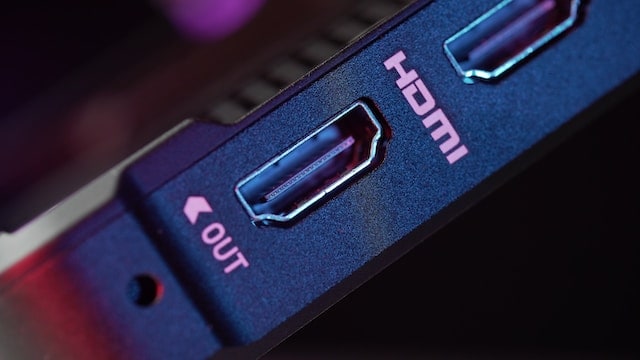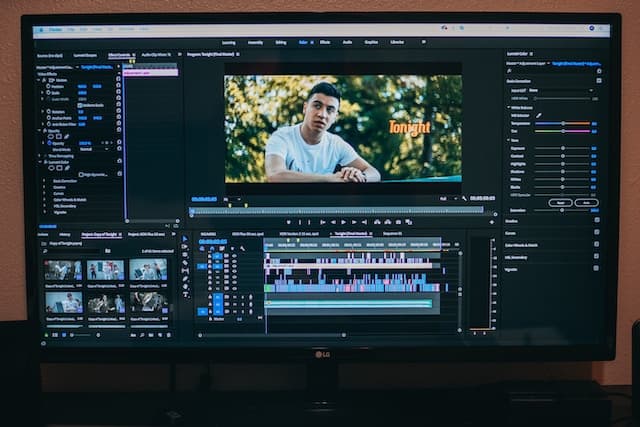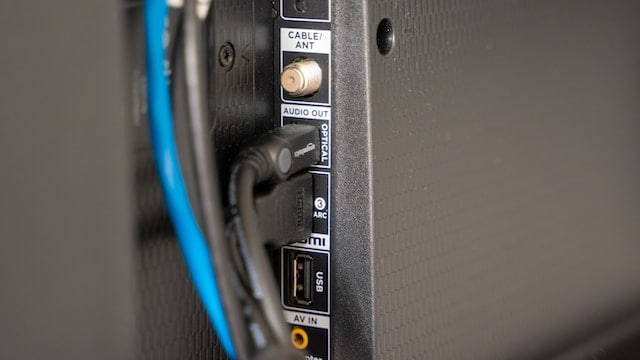Welcome to our article about HDMI 2.1 and Dolby Atmos. If you’re in the market for a new TV or home theater system, you’ve probably heard about these two technologies. But what are they, and how do they enhance the audio experience?

HDMI 2.1 is the latest version of the HDMI (High-Definition Multimedia Interface) standard, and it offers a range of improvements over its predecessor, HDMI 2.0. One of the most significant enhancements is the increased bandwidth, which allows for higher resolutions and faster frame rates. Dolby Atmos, on the other hand, is an audio technology that creates a more immersive sound experience by placing sounds in a three-dimensional space around the listener. Together, HDMI 2.1 and Dolby Atmos can provide a truly cinematic experience in your own home.
In this article, we’ll explore the features and benefits of HDMI 2.1 and Dolby Atmos, and how they work together to create a more immersive audio experience. We’ll also discuss the evolution of HDMI 2.1 from HDMI 2.0, as well as enhancements in frame rates, dynamic HDR, and more. Whether you’re a movie buff, a gamer, or just looking to upgrade your home entertainment system, this article will help you understand how HDMI 2.1 and Dolby Atmos can take your audio experience to the next level.
Key Takeaways
- HDMI 2.1 and Dolby Atmos work together to create a more immersive audio experience.
- HDMI 2.1 offers higher resolutions, faster frame rates, and enhanced features like VRR and QFT.
- Dolby Atmos places sounds in a three-dimensional space around the listener, creating a truly cinematic experience.
Understanding HDMI 2.1 and Dolby Atmos
HDMI 2.1 is the latest version of the High-Definition Multimedia Interface (HDMI) standard that offers a range of new features and improvements over its predecessor, HDMI 2.0. One of the most significant enhancements of HDMI 2.1 is its ability to support higher video resolutions and faster refresh rates, making it ideal for gaming and streaming high-quality content.
Dolby Atmos, on the other hand, is an advanced audio technology that provides an immersive sound experience by creating a three-dimensional sound field. It places sound objects in a 3D space, allowing you to hear sounds from all directions, including from above and below.
When used together, HDMI 2.1 and Dolby Atmos can enhance the overall audio and video experience by delivering high-quality sound and video. HDMI 2.1 provides the necessary bandwidth to transmit Dolby Atmos audio signals, allowing you to enjoy a more immersive audio experience.
With HDMI 2.1, you can also enjoy higher-quality video resolutions, including 8K and 4K at 120Hz. This means you can watch movies and play games with higher picture quality and smoother motion. Dolby Atmos, on the other hand, provides a more realistic and immersive sound experience, making it ideal for movies, music, and gaming.
Overall, the combination of HDMI 2.1 and Dolby Atmos offers a more immersive and realistic audio and visual experience, making it an excellent choice for those who want to enjoy high-quality entertainment.
The Evolution from HDMI 2.0 to HDMI 2.1

HDMI 2.1 is the latest version of the HDMI standard, which offers several improvements over its predecessor, HDMI 2.0. While HDMI 2.0 was a significant upgrade from the earlier HDMI 1.4, HDMI 2.1 takes things to a whole new level.
One of the most significant improvements in HDMI 2.1 is the increased bandwidth, which allows for higher resolutions and faster frame rates. HDMI 2.1 supports resolutions up to 10K at lower frame rates, 8K at 60 frames per second, and 4K at 120 frames per second. This makes it ideal for use with the latest generation of gaming consoles and high-end home theater systems.
Another key feature of HDMI 2.1 is Enhanced Audio Return Channel (eARC), which expands the range of audio codecs you can use, including Dolby Atmos and DTS. This means that you can enjoy high-quality, immersive audio without the need for additional cables or equipment.
Compared to HDMI 2.0, which had a maximum bandwidth of 18 Gbps, HDMI 2.1 offers a massive 48 Gbps. This increased bandwidth allows for higher resolutions, faster frame rates, and more robust audio capabilities.
While HDMI 2.0b also supports the same audio formats as HDMI 2.1, it does not have the same bandwidth, which limits its capabilities. HDMI 2.0b can pass Dolby Atmos TrueHD, but it misses out on 4K at 120 frames per second.
Overall, HDMI 2.1 is a significant upgrade over HDMI 2.0 and offers several improvements that make it ideal for use with the latest generation of home theater systems and gaming consoles. With its increased bandwidth and enhanced audio capabilities, HDMI 2.1 is the future of home entertainment.
Bandwidth and Resolution: 4K, 8K and Beyond
HDMI 2.1 is a significant upgrade from its predecessor, HDMI 2.0b, in terms of bandwidth and resolution. With HDMI 2.0b, we could enjoy a maximum of 4K resolution at a maximum frame rate of 60Hz. However, HDMI 2.1 increases that anywhere from 4K at 120 frames per second to 8K at 60 frames per second, or all the way up to 10K resolution at lower frame rates.
This increased bandwidth and resolution means that we can now enjoy even more detailed and immersive audio and video experiences. For instance, with 8K TVs becoming more common, we can expect to see more content produced in 8K resolution. Additionally, the higher frame rates and increased bandwidth mean that we can enjoy smoother and more lifelike visuals, especially when it comes to fast-paced action scenes in movies and games.
Moreover, HDMI 2.1 also supports Ultra HD Blu-ray players, which can play 4K Ultra HD Blu-ray discs. These discs offer a significant improvement over regular 1080p Blu-ray discs, with better color, contrast, and dynamic range. With HDMI 2.1, we can enjoy these improvements to their fullest potential.
In conclusion, HDMI 2.1’s increased bandwidth and resolution capabilities mean that we can expect to see even more immersive and detailed audio and video experiences in the future. With more content being produced in 8K and beyond, and Ultra HD Blu-ray players becoming more common, now is the perfect time to upgrade to HDMI 2.1.
Enhancements in Frame Rates

HDMI 2.1 brings significant improvements to frame rates, making it ideal for gamers and movie enthusiasts alike. With a bandwidth throughput of 48 Gbits per second, HDMI 2.1 can support higher frame rates of up to 120 frames per second (fps). This enhancement provides smoother and more fluid motion, making fast-paced action scenes and sports games much more enjoyable to watch.
The increased frame rates also mean that gamers can enjoy a more immersive experience with reduced lag and faster response times. The high frame rates allow for more precise and accurate movements, giving gamers an edge in competitive gameplay.
Moreover, HDMI 2.1 supports variable refresh rates (VRR), which synchronizes the display’s refresh rate with the frame rate of the content being played. This feature reduces screen tearing and stuttering, resulting in a smoother and more seamless gaming experience.
In addition, HDMI 2.1 can support 4K resolution at 120 fps or even 8K resolution at 60 fps. This means that users can enjoy high-quality content with stunning visuals and smooth motion.
Overall, the enhancements in frame rates with HDMI 2.1 provide a significant improvement in the audio-visual experience. Whether it’s gaming or watching movies, the higher frame rates and reduced lag make for a more immersive and enjoyable experience.
Dynamic HDR and Dolby Vision
Dynamic HDR is a technology that adjusts the picture on a scene-by-scene basis to reveal more detail and color. It is a feature of the HDMI 2.1 standard, which is quickly becoming the new standard for state-of-the-art TVs, A/V receivers, and next-gen gaming systems. Dynamic HDR is also present in two proprietary formats, HDR10+ and Dolby Vision.
HDR10+ is an open standard that uses dynamic metadata to adjust the picture on a scene-by-scene basis. It is a direct competitor to Dolby Vision, which is a proprietary format developed by Dolby Labs. Dolby Vision allows content producers to have either one or two ‘layers’ of data; one carrying just an HDR signal, the other carrying a standard dynamic range (SDR) signal. This single HDR/SDR workflow approach makes Dolby Vision a convenient tool for content creators and broadcasters to use.
Both HDR10+ and Dolby Vision are designed to work with the wider color gamut of BT.2020, which can display over a billion colors. This wider color gamut allows for more vivid and lifelike colors, making content appear more realistic.
In summary, Dynamic HDR, HDR10+, and Dolby Vision are all technologies that allow for more detailed and colorful pictures on a scene-by-scene basis. While HDR10+ is an open standard, Dolby Vision is a proprietary format developed by Dolby Labs. Both formats are designed to work with the wider color gamut of BT.2020, which can display over a billion colors.
Variable Refresh Rate (VRR) and Quick Frame Transport (QFT)

Variable Refresh Rate (VRR) and Quick Frame Transport (QFT) are two features that are designed to improve the gaming experience by reducing display latency and increasing responsiveness. VRR reduces or eliminates lag, judder, and frame tearing for more fluid and better-detailed gameplay. It enables a gaming source such as a console or computer to deliver video frames as fast as it can, which in many cases is slower than the normal static refresh rate.
QFT, on the other hand, operates on the transport portion of the equation by reducing the time it takes to send only the active video across the cable. This results in reduced display latency and increased responsiveness.
Both VRR and QFT are available with HDMI 2.1, which provides a bandwidth throughput of 48 Gbits per second. Using display stream compression (DSC), HDMI 2.1 can push a 10K signal at 120 frames per second in 12-bit color.
VRR and QFT are particularly useful for fast-paced games that require quick reflexes and precise timing. They provide a smoother and more immersive gaming experience by reducing lag and improving responsiveness. With these features, gamers can enjoy their games to the fullest without any distractions or interruptions.
In summary, VRR and QFT are two features that are designed to improve the gaming experience by reducing display latency and increasing responsiveness. They are particularly useful for fast-paced games that require quick reflexes and precise timing. With HDMI 2.1, gamers can enjoy a smoother and more immersive gaming experience than ever before.
Audio Return Channel and Enhanced Audio Return Channel
Audio Return Channel (ARC) is a feature that allows audio to be sent from a TV to an external audio device, such as a soundbar or receiver, through an HDMI cable. This means that you only need one HDMI cable to send both audio and video signals to your TV.
ARC was introduced in HDMI version 1.4, but it had some limitations. For example, it could only support compressed audio formats like Dolby Digital and DTS. Additionally, it had limited bandwidth, which meant that it couldn’t support higher-quality audio formats like Dolby Atmos.
Enhanced Audio Return Channel (eARC) is an updated version of ARC that was introduced with HDMI version 2.1. It has a much higher bandwidth than ARC, which means that it can support higher-quality audio formats like Dolby Atmos and DTS. It can also support uncompressed audio formats like LPCM.
One of the benefits of eARC is that it can automatically correct processor delays, which ensures that your audio and video are always in sync. It also supports lip sync correction, which is important when watching movies or playing games.
It’s important to note that both your TV and audio device must support eARC for you to take advantage of its benefits. If only one device supports eARC, you can still use ARC, but you won’t be able to enjoy the higher-quality audio formats that eARC supports.
In summary, eARC is an updated version of ARC that offers higher bandwidth and supports higher-quality audio formats like Dolby Atmos. It can also automatically correct processor delays and supports lip sync correction. However, both your TV and audio device must support eARC for you to take advantage of its benefits.
Dolby Atmos and Sound Quality

Dolby Atmos is a revolutionary technology in the world of audio. It is an object-based sound system that provides an immersive audio experience, making you feel like you are a part of the action. With Dolby Atmos, sound moves in all directions, including above and below you. This creates a more realistic and engaging audio experience.
Dolby Atmos supports a wide range of audio formats, including Dolby TrueHD and Dolby Digital Plus. These are lossless audio formats that provide superior audio quality compared to traditional surround sound formats. With Dolby Atmos, you can enjoy the full potential of these audio formats.
The audio quality of Dolby Atmos is exceptional, thanks to its object-based sound system. It provides a more accurate and precise soundstage, making it easier to distinguish between different sounds. This makes it ideal for movies and TV shows, where the audio is an essential part of the experience.
In addition to movies and TV shows, Dolby Atmos is also great for gaming. It provides a more immersive gaming experience, allowing you to hear every sound in the game with greater clarity. This can give you a competitive advantage in games where sound is critical.
Overall, Dolby Atmos is a game-changer in the world of audio. It provides an immersive and engaging audio experience that is unmatched by traditional surround sound formats. If you are a fan of movies, TV shows, or gaming, then Dolby Atmos is a must-have technology for you.
Auto Low Latency Mode and Quick Media Switching
Auto Low Latency Mode (ALLM) and Quick Media Switching are two features of HDMI 2.1 that enhance the audio-visual experience.
ALLM enables connected displays and AV receivers to automatically enter low-latency mode, also known as “game mode,” when the user plays a video game. This allows for smooth and lag-free interactivity. The setting automatically returns to normal when ordinary video content, such as a TV show or movie, is played.
Quick Media Switching, on the other hand, eliminates the blackout period when an HDMI source device switches its video mode. With HDMI 2.1a, Quick Media Switching for movies and video uses the HDMI Variable Refresh Rate (VRR) mechanism.
These features are particularly useful for gamers, as they allow for a seamless and uninterrupted gaming experience. However, they also benefit anyone who wants a smoother and more responsive audio-visual experience.
HDMI 2.1 and Streaming Services

Streaming services like Netflix, Amazon Prime Video, Disney+, and Apple TV+ are becoming increasingly popular among users. With the advent of HDMI 2.1, these services can now offer an even better audiovisual experience to their users.
HDMI 2.1 offers higher bandwidth and faster data transfer rates, enabling streaming services to offer higher resolution videos and better sound quality. With support for up to 48Gbps, HDMI 2.1 can deliver 4K and 8K videos at higher frame rates, providing a more immersive viewing experience.
Moreover, streaming services can now offer better audio quality with HDMI 2.1. With the support of eARC (Enhanced Audio Return Channel), HDMI 2.1 can transmit high-quality audio formats such as Dolby Atmos and DTS. With eARC, the audio data can be transmitted back to the AV receiver or soundbar without any loss of quality, providing a more realistic and immersive sound experience.
Netflix, Amazon Prime Video, Disney+, and Apple TV+ are already offering content with Dolby Atmos support. With HDMI 2.1, users can experience the full potential of Dolby Atmos, which provides a three-dimensional sound experience that makes you feel like you are in the middle of the action.
In conclusion, HDMI 2.1 is a game-changer for streaming services, enabling them to offer higher quality videos and better sound quality. With support for Dolby Atmos and other high-quality audio formats, users can now experience a more immersive sound experience while watching their favorite shows and movies.
HDMI 2.1 and Gaming Consoles
HDMI 2.1 is a must-have feature for gamers who want the best possible gaming experience. It offers several features that can improve the gaming experience, especially when paired with the latest gaming consoles like the PS5 and Xbox Series X.
One of the most significant features of HDMI 2.1 for gaming is its support for Variable Refresh Rate (VRR) and Quick Frame Transport (QFT). These features help to reduce input lag and ensure a smoother and more responsive gaming experience. The PS5 and Xbox Series X both support these features, making them ideal for gamers who want the best possible performance.
Another feature of HDMI 2.1 that is important for gaming is its support for Auto Low Latency Mode (ALLM). This feature allows the TV to automatically switch to its lowest input lag mode when it detects that a game is being played. This can help to reduce input lag and improve the overall gaming experience.
Finally, HDMI 2.1 also supports eARC, which is an update to the Audio Return Channel (ARC) connection. This feature allows for higher-quality audio, including support for advanced audio formats like DTS and Dolby Atmos. Both the PS5 and Xbox Series X support these audio formats, making them ideal for gamers who want the best possible audio experience.
In summary, HDMI 2.1 is a must-have feature for gamers who want the best possible gaming experience. It offers several features that can improve the gaming experience, especially when paired with the latest gaming consoles like the PS5 and Xbox Series X. With support for VRR, QFT, ALLM, and eARC, HDMI 2.1 is the perfect choice for gamers who want the best possible performance and audio quality.
HDMI 2.1 Cables and Compatibility

HDMI 2.1 is the latest version of the HDMI (High-Definition Multimedia Interface) standard. It offers a number of improvements over its predecessor, including higher resolutions, higher frame rates, and more bandwidth. To take advantage of these improvements, you’ll need to use HDMI 2.1 cables.
One of the great things about HDMI 2.1 is that it is backwards-compatible with previous versions of HDMI. This means that you can still use your existing HDMI cables with new HDMI 2.1 devices. However, to take full advantage of the new features offered by HDMI 2.1, you’ll need to use HDMI 2.1 cables.
There are different types of HDMI 2.1 cables available, including standard HDMI 2.1 cables and Ultra High Speed HDMI cables. Ultra High Speed HDMI cables offer even greater bandwidth, making them ideal for use with devices that require the highest possible data transfer rates.
It’s worth noting that not all HDMI 2.1 devices support all of the features offered by the standard. For example, some devices may not support Dolby Atmos, which is a surround sound technology that provides a more immersive audio experience. If you want to take advantage of Dolby Atmos, you’ll need to make sure that your device supports it.
Finally, it’s worth mentioning that HDMI 2.1 is a licensed technology, and manufacturers must obtain a license from the HDMI Licensing Administrator in order to use it. This helps to ensure that HDMI 2.1 devices are reliable and compatible with other HDMI 2.1 devices.
TVs and AV Receivers with HDMI 2.1
HDMI 2.1 is quickly becoming a new standard for state-of-the-art TVs and AV receivers. This new HDMI specification offers a lot of improvements over its predecessor, HDMI 2.0, including higher resolutions, higher frame rates, and a lot more bandwidth. This makes it ideal for gaming, sports, and movies.
Many of the top TV manufacturers, including LG, Sony, Samsung, and Vizio, have already released TVs with HDMI 2.1 support. These TVs offer a range of features, including 4K and 8K resolution, HDR support, and high refresh rates up to 144Hz. They also come with a range of smart features, including voice control and built-in streaming services.
AV receivers with HDMI 2.1 support are also becoming more common. They offer a range of features, including support for Dolby Atmos and DTS, multiple HDMI inputs, and 4K and 8K passthrough. Some of the top AV receiver brands with HDMI 2.1 support include Denon, Marantz, and Yamaha.
When choosing a TV or AV receiver with HDMI 2.1 support, it’s important to consider your specific needs and preferences. Some TVs and AV receivers may offer more advanced features than others, so it’s important to do your research and read reviews before making a purchase.
Overall, TVs and AV receivers with HDMI 2.1 support offer a range of benefits for those looking to enhance their audio and visual experience. With support for higher resolutions, higher frame rates, and more bandwidth, these devices are an excellent choice for gamers, sports fans, and movie enthusiasts alike.
Conclusion
HDMI 2.1 and Dolby Atmos are two powerful technologies that work together to enhance the audio experience. By using HDMI 2.1 cables and eARC ports, you can get uncompressed, full-resolution audio that is perfect for Dolby Atmos.
With HDMI 2.1’s increased bandwidth, you can enjoy a wider range of audio formats, including Dolby Atmos, which is a perfect example of how eARC can improve your audio experience. With eARC, you can get lip sync correction and automatically correcting processor delays so that your audio and video always match.
By connecting your TV to your AVR or soundbar using an HDMI cable, you can transform your TV into a device hub and pass uncompressed audio via the eARC port to your AVR or soundbar. This approach ensures that you get the best sound from your TV.
In conclusion, HDMI 2.1 and Dolby Atmos are two powerful technologies that can enhance your audio experience. By using eARC and HDMI 2.1 cables, you can enjoy high-quality audio that is perfect for movies, TV shows, and gaming.
- The Evolving Threat Securing the Final Layer: How Screen Watermarking Protects Organizations from Insider Threats Landscape in ASEAN - October 8, 2025
- The Camera Set That Makes Tracking Real: Discover What It Does and Why You Need It - October 2, 2025
- Trending Trousers: The Must-Have Styles for Women - September 26, 2025